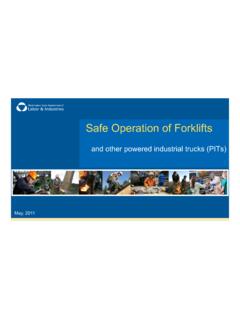Transcription of Overhead Crane Safety and Prevention - Wa
1 Overhead Crane Safety and Prevention Overhead Crane Safety and Prevention Funding and support for this project has been provided by the State of Washington, Department of Labor & Industries, Safety & Health Investment Projects Overhead Crane Safety and Prevention Training Objectives Part I Crane Basics Types of Cranes The Parts of the Crane Inspecting the Crane Maintaining the Crane Part II Crane Safety Communication Basic Crane Safety Crane Safety Tools Warning Markers and Hand Signs Part III Safe Crane Operational Procedures Loads and Lifts Testing Operational Qualifications Conduct of Operators Overhead Crane Safety and Prevention Part I Crane Basics Overhead Crane Safety and Prevention Types of Cranes Gantry Cranes Jib Cranes Bridge Cranes Monorail Cranes Overhead Crane Safety and Prevention Types of Cranes A type of Crane that is built upon a bridge-like Overhead structure (gantry).
2 Gantry Cranes Overhead Crane Safety and Prevention Types of Cranes Bridge Cranes An Overhead Crane that consists of parallel runways with a traveling bridge. Overhead Crane Safety and Prevention Types of Cranes Monorail Cranes A type of Overhead Crane that travels suspended on a single rail. Overhead Crane Safety and Prevention Types of Cranes Jib Cranes A type of Crane where a horizontal beam extends out to lift and move a load along the beam. Overhead Crane Safety and Prevention Crane Operators Hoist Operator The employee that uses the hoist to lift, lower, and move a load by means of an Overhead Crane . Rigger The employee that is responsible for balancing and securing the load to the hook, and will direct the hoist operator during the lift. Overhead Crane Safety and Prevention The Parts of the Crane Hoisting Mechanisms Hoist Drum Wire Rope Hoist Block Hook Overhead Crane Safety and Prevention The Parts of the Crane Overhead Parts Trolley Pendant Runaway Beam Bridge Bumpers End Trucks Overhead Crane Safety and Prevention The Parts of the Crane Safety Parts Power Supply Fire Extinguisher Load Rating Overhead Crane Safety and Prevention Inspecting the Crane Inspections are one of the tools that are used to help prevent machine breakdowns and accidents.
3 Three Types of Inspections: (Daily) Inspections Inspections Inspections Overhead Crane Safety and Prevention Inspecting the Crane Day-to-Day Inspections Day-to-Day inspections should be small inspections that occur before the beginning of a shift or before using the Crane for the first time each work day. Day-to-Day inspections should include: -Inspect the wire rope for abnormalities and/or damage. -Inspect the drum for proper rope alignment. -Inspect the area around the machine for any indication of leaking or dripping fluids. -Inspect the block and hook for any cracks or damage. -Visually inspect any bumpers for damage or abnormalities. - Visually inspect Limit Switches for abnormalities and test for proper functionality. Overhead Crane Safety and Prevention Inspecting the Crane Frequent Inspections Frequent Inspections are visual examinations by the operator or other designated personnel with written records not required.
4 Frequent Inspections should include: -Operating mechanisms for proper operation, proper adjustment, and unusual sounds. -Upper-Limit device(s) in accordance with ASME standards. -Tanks, Valves, pumps, lines and other parts of air or hydraulic systems for leakage. -Hooks and hook latches (if used) in accordance with ASME standards. -Hoist ropes and end connections in accordance with ASME standards. -Rope and proper spooling on the drum(s) and sheave(s). Overhead Crane Safety and Prevention Inspecting the Crane Periodic Inspections Periodic Inspections are visual inspections of the equipment in place by a designated person making records of apparent external conditions to provide the basis for a continuing evaluation. Periodic Inspections should include: -Deformed, cracked or corroded members. -Loose or missing bolts, nuts, pins or rivets. -Cracked or worn sheaves and drums.
5 -Worn, cracked, or distorted parts. -Excessive wear of brake system parts. -Excessive wear of drive chain sprockets and excessive drive chain stretch. -Deterioration of controllers, master switches, contacts, limit switches, and push-button stations. -Gasoline, diesel, electric, or other power plants for proper operation. -Motion-limit devices that interrupt power or cause a warning to be activated. -Rope reeving for compliance with Crane manufacturers design. -All function, instruction, caution, and warning labels or plates for legibility and replacement. Overhead Crane Safety and Prevention Inspecting the Crane Cranes Not in Regular Service Cranes that have been sitting idle for a period of 1 month or more, but less then 1 year, should have a Frequent Inspection before entering service. Cranes that have been sitting idle for a period of 1 year or more, should have a Periodic Inspection before entering service.
6 Overhead Crane Safety and Prevention Inspecting the Crane Wire Rope Inspections Properly inspecting the rope, and keeping an eye out for changes in the rope, is important to maintaining a safe work environment. Overhead Crane Safety and Prevention Wire Rope Inspections Waviness Waviness is a deformation in which the longitudinal axis of the wire rope takes the shape of a helix under either a loaded or unloaded condition. Overhead Crane Safety and Prevention Wire Rope Inspection Basket/Lantern Deformation (Birdcage) A basket, or lantern, deformation, also known as a birdcage, develops when the outer layer of strands in the wire rope becomes longer than the inner layer(s). Overhead Crane Safety and Prevention Wire Rope Inspection Core Protrusion/Distortion A core protrusion is a special type of basket or lantern deformation. In this case the rope imbalance is indicated by a protrusion of the core of the wire rope.
7 Overhead Crane Safety and Prevention Wire Rope Inspection Strand Protrusion/Distortion A strand protrusion, or distortion, is when one of the outer strands of the wire rope protrudes out. Overhead Crane Safety and Prevention Wire Rope Inspection Wire Protrusion When certain wires, or groups of wires, will rise up on the side of the rope opposite to the sheave groove in the form of loops. Overhead Crane Safety and Prevention Wire Rope Inspection Local Increase in Diameter of Rope A local increase in rope diameter can occur and might effect a relatively long length of the rope. Overhead Crane Safety and Prevention Wire Rope Inspection Flattened Portion A flattened portion of a rope is a section of the rope that has lost its circular form. Overhead Crane Safety and Prevention Wire Rope Inspection Kinks A kink is a deformation created by a loop in the rope which has been tightened without allowing for rotation about its axis.
8 Overhead Crane Safety and Prevention Wire Rope Inspection Other Kink Examples Positive Kink Negative Kink Overhead Crane Safety and Prevention Maintenance Maintenance Topics with Overhead Cranes: Maintenance Procedures and Repairs Maintenance and Replacement Overhead Crane Safety and Prevention Maintenance Preventive Preventive Maintenance is maintenance that is conducted before an issue is identified. This includes, but is not limited to: - Fluid Replacement - Frequently Worked Parts - Pads - Hoses - Warning Devices and Signs Overhead Crane Safety and Prevention Maintenance Maintenance Procedures The following precautions shall be taken before performing any maintenance on a Crane : (1)The Crane shall be moved to a location where it will cause the least interference with other cranes and operations in the area. (2)If a load is attached to the Crane , it shall be landed.
9 (3)All controllers shall be placed in the off position. (4)A lockout/tagout procedure shall be performed. (5)Warning signs and barriers shall be utilized on the floor beneath the Crane where Overhead maintenance work creates a hazard. (6)If the runway remains energized, stops or a signalperson, located full-time at a visual vantage point for observing the approach of an active Crane , shall be provided to help the persons performing maintenance with the machine. (7)A guard or barrier shall be installed between adjacent runways for the length of any established work area. Overhead Crane Safety and Prevention Maintenance Adjustments and Repairs The following list is an example of components that might need adjustment or repairs: (1)operating mechanisms on the Crane (2)limit devices (3)control systems (4)brakes (5)damaged or worn hooks (6)critical parts that are cracked, broken, bent, or excessively worn (7) pitted or burned electrical contacts (8) function, instruction, caution, and warning labels Overhead Crane Safety and Prevention Maintenance Wire Rope Maintenance and Replacement If left in service long enough, wire ropes will deteriorate and eventually break.
10 While maintenance precautions on the rope can be taken, the strain on the rope will eventually lead to the need for it to be replaced. Overhead Crane Safety and Prevention Part II Crane Safety Communications Overhead Crane Safety and Prevention Basic Crane Safety one but a regularly authorized operator is allowed to use any Crane . not carry a load over people on the floor. Sound warning devices to alert persons nearby. not allow anyone to ride on a load carried by the Crane or on the Crane hook. try to stop the load with your hands or body. equipment daily before use. Always keep an eye out for changes in the equipment and Safety area. pull a hoist by the pendant cable. leave the controls unattended while a load is suspended. Lower the load to the floor if it is necessary to leave the controls. moving the trolley or bridge, be sure that the hook is high enough to clear all obstacles.










